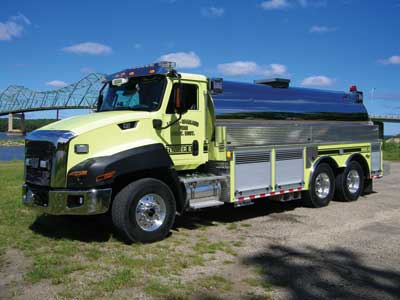 |
Alan M. Petrillo |
Specifically, Lacon-Sparland’s truck committee wanted a minimum 500-gallon-per-minute (gpm) midmount pump, a larger water tank, plenty of compartment space to allow for additional equipment storage in the future, and a closer cab-to-water-tank fit. And, the district wanted it all on a Caterpillar (CAT) chassis.
“Our Ford tanker was 24 years old and had a steel tank, so it was good timing for us to replace it,” says Brian Snyder, Lacon-Sparland’s chief. “For this vehicle, we didn’t go out to bid but instead sat down with Stan Froelich, the salesman at Alexis, to see what they could do for us.”
Snyder points out that Jeff Morris, the president of Alexis, sat in on spec meetings and helped make things happen for the fire district. “We wanted a tank that was closer to the cab so there was no gap between the two,” Snyder notes. “So, Alexis worked with the tank manufacturer and customized the tank so it fit the way we wanted. We also wanted to try to build it on a Caterpillar chassis.”
Click here to view the image gallery
Chassis
Froelich says the Lacon-Sparland tanker is one of the first fire trucks in the country to be built on a CAT chassis. “The fire district spec’d out the chassis, and we gave them the wheelbase and weight distribution engineering, which they took to Altorfer Inc., the authorized CAT dealer in Peoria, to have the chassis built.”
The resulting vehicle is mounted on a CAT CT660S two-door tandem chassis with a 66,000-pound gross vehicle weight rating (GVWR) and a 219-inch wheelbase; an overall length of 31 feet, five inches; and an overall height of 10 feet, four inches. The tanker is powered by a CT14 410-horsepower diesel engine and CAT CX31 automatic transmission. It carries a 3,500-gallon elliptical polypropylene water tank with a stainless steel wrap.
Snyder points out that his truck committee compared the CAT chassis and 13-liter diesel engine to a Peterbilt chassis with a comparable engine and ultimately decided to go with the CAT product. “We have a locking differential and locking rear end on the driveline that allow us to get across less stable ground-rocky areas, gravel, dirt, and snow,” Snyder says. “We are able to lock all the rear wheels together on the tandem axle.”
The tanker also carries a 4,000-gallon portable tank bladder on the right side of the tanker, accessed using a Zico electric rack. “We’re very happy with the way everything is laid out on the vehicle, especially how there is plenty of storage that we can grow into,” Snyder notes.
Froelich says the Alexis tanker has a customized Whelen red split lens LED warning light package all around on the vehicle. “There’s also a 2½-inch preconnected hose tray above the dump valve at the rear, as well as a dead-hoselay tray below the dump valve. The back end also has a color backup camera and arrow sticks for safety.”
The department used every available space on the rig, Froelich points out. “On the right-side wheel well there is a compartment that houses three air bottles, and on the left-side wheel well there’s a compartment that holds a low-level strainer,” he says.
Challenges
A couple of issues surfaced during the build out of the Alexis tanker, Snyder says. “Getting the tank closer to the cab was probably the biggest hurdle that we faced, but Alexis handled that beautifully,” he says. “We also wanted a remote controlled spotlight system on the top of the cab, but the tanker is going into an older station where the overall height is limited. So, we were not able to put the spotlight system on top of the cab and ended up with brow lights on the vehicle.”
Other issues facing the Alexis team, Snyder says, included the fact that the visor on the front of the tanker ended up blocking some of the Whelen emergency lights. Alexis modified the visor to accommodate the warning lights, he says. “Also, we wanted a mechanical dump valve on the back of the tanker, but the lever would have been in an inconvenient spot,” Snyder points out. “So, Jeff (Morris) convinced us to go with a Newton electrical dump valve, with a switch on each side of the vehicle, which has worked out fine.”
Snyder notes that the majority of the calls that Lacon-Sparland’s tanker runs are mutual aid calls. “It goes out a lot to help neighboring departments,” he says, “but the other day we had a garage fire where we were able to extinguish it with the water that was on our new tanker.”
ALAN M. PETRILLO is a Tucson, Arizona-based journalist and is a member of the Fire Apparatus & Emergency Equipment editorial advisory board. He served 22 years with the Verdoy (NY) Fire Department, including in the position of chief.
specs
Alexis Fire Equipment Tanker
Price without equipment: $330,000
department
Lacon-Sparland (IL) Fire Protection District
Strength: 26 volunteer firefighters, two stations.
Service area: Provides fire protection and rescue services to the city of Lacon and the village of Sparland in Marshall County, Illinois. The fire district lies on the east shore of the Illinois River, encompasses 1.64 square miles, and has a population of 1,937. The two towns are part of the Peoria, Illinois, metropolitan area.
Other apparatus: 2010 Alexis International pumper-tanker, 1,000-gallon-per minute (gpm) pump, 2,000-gallon water tank with rear dump valve; 2004 Alexis International pumper-tanker, 1,000-gpm pump, 1,250-gallon water tank, rear dump valve; two Alexis Ford F-350 brush trucks, one with a 300-gallon tank and one with a 350-gallon tank, both with 350-gpm pumps; one command vehicle; one 22-foot flat-bottom fire-rescue boat with 110-horsepower outboard engine.


